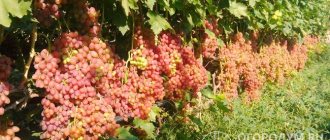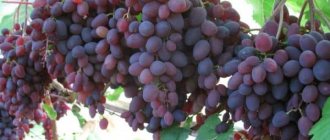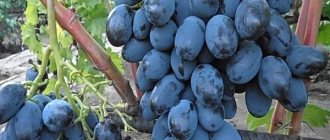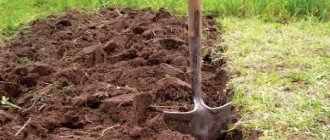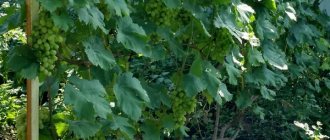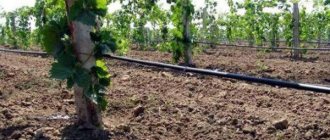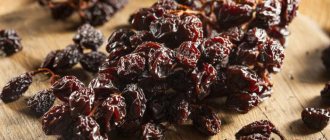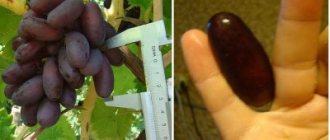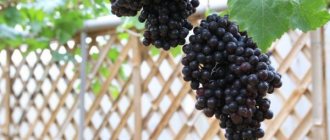Advantages and disadvantages
Pros:
- The fruits of the variety are distinguished by excellent presentation.
- High yield - up to 40 - 60 kg per bush.
- High resistance to fungal diseases.
- Frost resistance.
- High ripening of shoots, most of which are fruitful.
- High rates of adaptability.
- Easy to care for.
Minuses:
- Tendency to cracking berries.
- The presence of only female flowers.
- Attractive to wasps and grape mites.
- Low indicators of transportability and long-term storage.
Reference ! The “Victoria” grape (Russia) should not be confused with other varieties with similar names: “Victoria Genge” (Hungary), “Victoria” (Romania), “White Victoria” (Ukraine).
Resistance to diseases and pests
Experts assess the resistance of the Victoria grape variety to pathogenic environments and pests as average.
In case of gross violations of agricultural cultivation techniques, the crop may suffer from the following diseases:
- Mildew (downy mildew) - spreads to all biomass, including inflorescences and fruits. It appears as a yellowish oily spot, which turns gray over time and becomes covered with whitish fluff. Subsequently, the foliage curls and crumbles, and the shoots dry out. At temperatures below +8°C and above +30°C, pathogenic microorganisms are not viable. To treat the crop, it is recommended to spray with a solution of copper sulfate (5%) followed by treating the stems with Bordeaux mixture. It is advisable to carry out the procedures in humid and warm weather. For prevention, the bushes are first sprayed when the vine reaches 20 cm, then after flowering. As an alternative, the drugs “Ordan”, “Mancozeb”, “Ridomil”, copper chloride oxide (0.4%) can come to the rescue. To prevent the development of the disease, it is recommended to do high-quality pruning in the spring, and not to over-moisten the soil in the summer. Also, do not use too much nitrogen-containing fertilizer.
- Oidium (powdery mildew) - spreads to all green parts of the bush, especially often found on fruits. Appears as an ash-gray coating. In advanced cases, the plant stops growing, turns brown and gradually begins to fade. Thick shoots become sensitive to frost. Favorable conditions for the development of oidium are dampness and the absence of rain (rainwater washes away fungal spores). Solutions of Bordeaux mixture, as well as potassium permanganate (0.05%), soda ash (0.5%), Fundazol (0.2%), Topaz, Tilt-250 are effective in combating the disease. For prevention, the first treatment is desirable in the spring, when the leaf buds begin to open. Subsequent treatment is indicated before and after flowering. Colloidal sulfur (1%) can be used in these treatment phases. If the situation does not improve, repeated treatments are indicated every 2 weeks.
- Gray rot - spreads mainly to one-year-old wood, as well as green shoots, foliage, inflorescences, and berries. If no measures are taken, the grape clusters will rot on the vine. It manifests itself as plaque and brown spotting. In advanced cases, it threatens with the death of buds and withering of the stems. Preventive measures consist of regularly spraying the vineyard with Bordeaux mixture at two-week intervals. Treatment is carried out with fungicides "Ronilan" (0.1%), "Rovral" (0.75%).
- Bacterial cancer is dangerous for old branches, root collars, underground trunks, and grafting sites. It manifests itself as swelling of the bark, light growths that turn brown over time. As a result, the bush stops developing and withers. Before starting treatment, it is important to cut off all tumors and burn them. Then treatment of wounds with a solution of copper sulfate (5%) or copper naphthenate (5%) is indicated. The likelihood of complete relief from the disease is low, so experienced gardeners advise initially carefully inspecting young seedlings for the presence of galls and growths. If they are detected, the planting material must be replaced.
- Chlorosis occurs under conditions of excess or lack of moisture, poor-quality substrate, or lack of nutrients. It manifests itself as premature yellowing of foliage and stunted growth of the bush. For prevention, it is recommended to treat the vine with a solution of copper sulfate every autumn. Treatment is carried out with fungicidal drugs.
Important! Treatment with any drugs should be stopped approximately a month before the expected harvest.
Improper crop care creates favorable conditions for the appearance of harmful insects.
Dangerous for grapes:
- leaf roller - control is effective when using insecticides “Tokution”, “Tsimbush”, “Sumicidin”, “Ekamet”, “Cidial”, “Fozalon”, “Sevin”, “Parathion”;
- phylloxera - disinfection of bushes is carried out with insecticides “DI-68”, “Rogor”, “Rogor new”, “Danadim”, “Fufanon”, “BI-58 new”;
- ticks - drugs “Keltan” and “Fozalon” are recommended for control;
- mole crickets - it is recommended to water the soil with a solution of karbofos or benzophosphate;
- May beetles - control is carried out by mechanical collection of larvae, as well as adults, and their further destruction;
- wasps.
For the resistant Victoria variety, the greatest threat is from wasps, which flock to the juicy sweet berries during their ripening period. And if sucking parasites are easy to deal with thanks to insecticides (“Aktara”, “Aktellik”), then in this case such methods are ineffective.
You can get rid of wasps only by:
- destroying their nests;
- spraying shrubs with chlorophos;
- timely protection of the bush with a special net (this must be done before the berries begin to ripen).
The Victoria grape has many advantages, but, like other varieties, it requires basic care. Violations of agricultural cultivation techniques can be fraught with the development of diseases and death of the bush.
Origin
“Victoria” is the result of the efforts of employees of the All-Russian Research Institute of Vital and Vital Waters named after Ya.I. Potapenko. To develop this variety, a complex combination of frost-resistant hybrids was used: “save vilar 12-304”, “vitis amurensis” and “vitis vinifera”. The new grapes have become the epitome of excellent resistance to significant temperature drops and other adverse environmental factors.
Important! On the Internet, you can come across the erroneous opinion that “Victoria” is a clone of the “Uehara” variety, which appeared at a Japanese breeding station of the same name. The fact is that initially “Victoria was really called that because of the external similarity of the fruits of both varieties, but later the new Russian hybrid received its permanent name.
History of selection
This variety of culture was bred in the early 70s of the last century by specialists from the All-Russian Research Institute of Viticulture and Winemaking named after. Ya. I. Potapenko by interspecific hybridization: crossing the frost-resistant European-Amur hybrid (V. Vinifera L. x V. Amurensis) with the Save-Villar hybrid 12-304.
The hybrid form Save-Villar 12-304 is a direct producer that has complex resistance to diseases, phylloxera and frost, and is used for breeding purposes.
Thanks to a number of advantages obtained from the parent forms, “Victoria” is often used as a donor of valuable qualities not only by professionals, but also by amateur breeders to develop new grape varieties. The practical results of the enthusiastic winegrower Evgeniy Georgievich Pavlovsky would be a credit to another scientific institution. He created 26 new varieties, including such masterpieces of amateur selection as “Cherry” (“Victoria” x “Rizamat”), “Veronica” and “Pretty Woman” (“Victoria” x a mixture of pollen of European-Amur forms).
Detailed information about some of Pavlovsky's new products can be obtained from the following video:
These hybrids are not only successfully grown in household plots in various regions of Russia, but have also attracted the attention of producers, including some European countries. However, without proper testing, recognition of new forms as varieties and inclusion in the State Register of Breeding Achievements, their path to commercial vineyards is still closed.
Currently, the possibilities of growing this variety of crop are being assessed on experimental plots in the soil and climatic conditions of the southern and central regions of Belarus and the Kemerovo region of our country.
Main characteristics
“Victoria” is a high-yielding early grape variety that has an unobtrusive pleasant taste and a very beautiful yellow color of the berries. It is also worth noting other high-yielding varieties, such as “delight”, “transformation” and “Arcadia”.
Ripening period
“Victoria” is considered an early ripening variety, since the duration of its growing season is 115–120 days. The beginning of the harvest in the regions of Central Russia occurs in the middle - end of August.
Bush
The “Victoria” variety bush is characterized by weak or medium growth vigor, but about 70–90% of its shoots are fruitful, which ensures high productivity with a relatively compact plant.
The leaves are rich green in color, medium in size, slightly downy.
The flower is functionally female. This means that the variety is quite fruitful, provided that bushes of other grape varieties capable of pollinating “Victoria” are planted next to it.
Bunches and berries
The bunches are quite weighty: the average mass of a brush is 300 grams ; with properly organized care, these figures can increase significantly - from 600 to 700 grams. The shape of the bunches is conical, their structure is moderately dense, sometimes even loose.
“Victoria” berries are characterized by an ovoid shape and medium size: 2.7 by 2.2 cm with a weight of 6 – 7 grams. Externally, they attract attention due to their bright, rich color: the thin, almost transparent skin is filled with red-raspberry color, which is unevenly distributed over the surface of the berry. The pulp is juicy, dense, crispy, containing 1 – 3 seeds.
Sparavka! Technical indicators of the variety: sugar content – 18 – 19%, acidity level 5 – 6 g/l.
Taste
“Victoria” has a pleasant and harmonious taste, which, when the fruits are fully ripened, is saturated with bright nutmeg notes.
Productivity
The variety can safely be classified as high-yielding, since about 40–60 kg of crop is usually harvested from one bush.
Description of the plant and specifics of cultivation
The vine is of medium vigor, with well-ripening shoots. The perennial parts of the bush are covered with reddish, coarse-fibrous bark. Fruitful shoots range from 70 to 80%, on average the load on each is 1.4 bunches (maximum - 1.8).
Bushes are weak-growing, with well-ripening shoots
The leaves are simple, medium-sized, five-lobed, slightly dissected, dark or light green, smooth, matte. The petiolar recess is open, with a sharp bottom and a neatly cut jagged edge. The flowers are slightly greenish, small (3-5 mm in diameter). A distinctive feature of “Victoria” is the functionally female type of flower. For stable fruiting, joint plantings with specially selected bisexual pollinating varieties that bloom at the same time are necessary. The best for this type of crop are “Platovsky”, “Crystal”, “Augustine”, etc. A Ukrainian gardener talks about the influence of pollinators on the size, shape and color of berries in a video:
Experienced winegrowers do not advise leaving thin shoots that have grown from the head of the bush for fruiting. The length of pruning fruit shoots significantly affects the plant's yield and the quality of the fruit. It is considered advisable to trim short - by 2-4 buds, or medium - by 6-8.
For "Victoria" it is recommended to leave approximately 25-30 healthy eyes per bush, when cultivating according to the type of double-armed cordon, including: planting according to a 3x2-2.5 m pattern, growing two mature strong shoots; creating a twisted trunk from them to two tiers of trellis wire at a height of 0.5-1 m; forming two horizontal shoulders of a cordon with fruit links, attaching green shoots to the wire of the third tier of the trellis, followed by free hanging.
Comparison with analogues
“Victoria” has a number of positive qualities and compares favorably with other early varieties of pink grapes.
| Sign | Variety | |||
| Victoria | In memory of the teacher | Azalea | Gourmand early | |
| Ripening period | 115 – 120 days | 100 -110 days | 100 – 110 days | 115 – 125 days |
| Frost resistance | -26C | -23C | -25C | -23C |
| Productivity | 40 – 60 kg | 10 – 20 kg | Up to 45 kg | 6 – 8 kg |
| Bunches | 300 – 700 g | 600 g – 2.5 kg | 600 g – 1.2 kg | 500 g – 1.3 kg |
| Taste | Harmonious with notes of nutmeg | Harmonious with notes of nutmeg | Harmonious, sweet | Muscat |
| Color | Red-raspberry | Pink cherry | Light pink | Pink |
| Disease resistance | Above average | Average | Above average | Above average |
| Shelf life | Up to 1 month | 3 months | 2 – 3 months | 2 – 3 months |
| Sugar accumulation | 18 – 19% | 18 – 20% | 21 – 23% | 12 – 14% |
| Acidity | 5 – 6 g/l | 6 – 8 g/l | 5 – 6 g/l | 7 – 8 g/l |
Reproduction. Landing
Victoria grapes are one of the most resistant varieties to frost down to -27 ° C, but despite this they still love warmth and sun. It is better to choose a warm time for planting; seedlings will be able to take root much better in such conditions. The best period for planting seedlings is the period between the end of March and the beginning of June. You can also cover the cuttings with something, which will speed up the plant’s adaptation to the new environment.
Planting grapes can be done in the fall, but in order for everything to go well and the grapes to take root, it is worth knowing a few nuances. Grapes can be propagated in two ways: planting seedlings and grafting.
Saplings
- In autumn, seedlings should be planted before frost so that they take root;
- It is worth choosing a place where there is a lot of sun and no drafts;
- Dimensions of the pit: depth about 1 m, the pit itself is 0.8/0.8 m;
- Before planting, you should put about 4-6 cm of crushed stone at the bottom of the hole. Next, mix the soil with organic fertilizers and dig in the seedling;
- The soil around the plant needs to be mulched with sawdust, humus, etc. This will give more oxygen to the roots of your plant;
- After planting, you need to water the seedling (about 2 buckets of water);
- It is worth maintaining the distance between planting seedlings. It should be from 1.5 m to 3 m.
Graft
- You need to graft onto another vigorous and healthy bush;
- A wedge-shaped cut must be made on the grafted cuttings, and a forked cut on the trunk of the rootstock;
- The cutting should be installed as close to the rootstock as possible. It is worth wrapping with fabric for better fastening;
- The joint must be lubricated with clay to prevent the occurrence of various diseases.
Features of cultivation
The young plant produces its first harvest after planting in 2–3 years.
Boarding time
The variety can be planted in both spring and autumn. Each period has its own advantages: a spring seedling will have time to take root well over the summer, while an autumn seedling will harden and become hardy already in the first winter of its life. But each season also has its own disadvantages: in summer, a fragile bush can die from drought, and in winter – from low frosts.
However, experienced winegrowers still prefer autumn planting of grapes. The main thing is to properly insulate the tender seedling. As covering materials, you can use a special non-woven fabric, dry soil or leaves. Some gardeners put a simple cardboard box with a hole for the top on top of the seedling, which is removed immediately after the onset of heat. Don’t forget about mulching the root zone.
The best time to plant a seedling in the fall is mid-October. The plant will not have time to start growing, which can significantly harm it, but it will have time to grow stronger before the first frost, which should occur no earlier than 2–3 weeks after planting.
Place and soil
For excellent yield indicators, the future location of the new grape bush must have the following characteristics:
- Abundance of light. It is unacceptable to plant a seedling in the shade created by buildings or tall trees. If it is planned to use the walls of buildings as a support for the grape vines in the future, then it is necessary to take into account that they should be located on the south side.
- There are no drafts that can significantly reduce the yield even in the flowering phase.
- Fertile soil, rich in useful components, can significantly increase the future harvest. It is better to plant seedlings in black soil or loam. In the absence of such, it is possible to “cultivate” the soil: 1–2 years before the expected planting date, significant doses of organic and mineral fertilizers should be added to it.
The recommended dimensions of the planting hole are 80 cm * 80 cm * 80 cm. These parameters are determined by the need to place all the necessary components at the bottom of the hole and carefully place the root system. The sequence of filling it out is as follows:
- The drainage layer is 5 cm crushed stone.
- A layer of fertile soil is 10 cm.
- A layer of two types of humus.
- A layer of fertile soil. The last three layers must be thoroughly mixed.
- On top of the fertile “mix” another layer of ordinary soil, taken when digging a hole, is poured, on top of which the plant is placed.
Reference ! The young seedling is buried up to the root collar. During the digging process, it is recommended to pour a bucket of water heated in the sun into the planting hole, and after compacting the top layer of soil, another 2 to 3 buckets and a layer of mulch.
Watering and fertilizing
Victoria berries are prone to cracking, so excess moisture can ruin the future harvest. During the season, the bushes need to be watered only three times, and a month before the start of harvesting, any soil moisture other than natural precipitation is contraindicated. If the summer turns out to be rainy, then it is advisable to stretch moisture-proof material over the bushes or build some kind of canopy.
“Victoria” responds well to fertilizing with organic and mineral fertilizers.
In the spring, before flowering, wood ash and nitrogen-containing fertilizers are usually added. During the formation of the ovary, fertilizing with phosphorus and potassium is appropriate.
Attention! To prevent the growth of weeds and excessive evaporation of moisture from the soil, it is advisable to mulch the tree trunk circles after weeding. The material for mulching can be sawdust, straw, peat. The recommended thickness of the mulch layer is 5–9 cm.
Trimming
The preferred bush shape is fan-shaped. In autumn, formative pruning of shoots with 2-3 eyes is performed. The total load on the bush should not exceed 30 buds.
The plant also needs crop rationing. The recommended average number of bunches is 1.8 per shoot.
To obtain a beautiful bunch, experienced winegrowers “comb it out” with a paint brush at the beginning of berry growth. All weak, damaged ovaries are removed under the influence of the fibers of the brush, leaving room for the growth of full-fledged berries.
Diseases and pests
The “Victoria” variety is characterized by high resistance to mildew, oidium, and gray rot, but it is still better to carry out preventive treatments with purchased fungicides. The fan formation of the bush will also help prevent the development of fungal infections, which will allow the clusters and shoots to be well ventilated, as well as moderate watering and timely removal of fallen leaves and weeds.
The main “enemies” are grape mites and wasps. An excellent way to combat mites is to treat the affected bush with insecticides “Confidor”, “Bi-58”, “Neoron”, colloidal sulfur, but no later than 3 weeks before harvest.
Special bags made of fine mesh, as well as crops of herbs or jars of sweet sugar or honey solution containing 0.5% chlorophos, can protect brushes from wasps.
Wintering
The variety is considered frost-resistant, since the vine can withstand down to -26ºС. But it is still worth covering the bush in regions with a temperate or harsh climate, but in the south you can omit this point about caring for the plant.
The covering process is no different from the generally accepted one. The lashes are removed from the support, laid on the ground, tied and covered with agrofibre, dry leaves or an earthen embankment.
Harvest storage
The peel of the berries is very thin; it is not able to provide adequate protection from mechanical damage, therefore the transportability characteristics of the variety are low.
It is better to store fruits in the refrigerator, cellar - where temperatures are close to 0ºС - +5ºС. If this requirement is met, they can last for about one month.
Rules for caring for the Victoria variety
In order for this variety to actively grow and produce a harvest, it requires proper care for at least 4 years.
Watering and fertilizing
The plant needs regular watering. But at the same time, you need to ensure that the soil does not become waterlogged. Otherwise, the bush is at risk of fungal diseases and infections.
Watering should be especially carefully monitored during flowering and fruit set. The total amount of soil moisture depends on the specific climatic region.
Watering
Important! To normalize soil moisture in the summer, it is recommended to install temporary greenhouses over the vineyards.
The plant must be fed with organic and mineral fertilizers. For each stage of grape growth, certain fertilizers are required:
- in early spring, components containing nitrogen are introduced;
- superphosphates are added when watering during the beginning of flowering;
- when preparing the bush for wintering, mixtures containing copper and potassium are added;
- zinc and boric acid are required during the establishment of a new crop.
Bush formation and pruning
Victoria needs to be pruned every spring. This is done before the bush begins to flower. The next pruning is done in the fall. This removes all summer growth of shoots. It is best to form a bush in the spring, since the autumn procedure can lead to the death of the plant.
Since Victoria produces rather heavy bunches of berries, it is recommended to tie up the branches, as they can break off under the weight of the harvest.
Shelter for the winter
To prepare the bush for wintering, it is necessary at the end of autumn to prepare a ditch in which the vine will be laid. When cold weather sets in, the shoots are placed in a prepared trench, covered with earth and covered with film.
Reproduction of the variety
In addition to seedlings, Victoria can reproduce in several other ways:
- your own roots;
- by grafting method.
Important! Victoria is grafted onto another vigorous variety. The rootstock area is cleaned and additionally tied with a tourniquet.
Useful properties and applications
The rich chemical composition of the Victoria grape fruit provides a number of positive effects on the entire body as a whole and on its individual life support systems.
| What does it affect? | Effect on the body |
| Nervous system and brain | Improves psycho-emotional state |
| Relieves the effects of stress | |
| Restores sleep | |
| Strengthens memory | |
| The cardiovascular system | Strengthens the walls of blood vessels |
| Clears the walls of blood vessels from cholesterol plaques | |
| Normalizes blood pressure | |
| Blood | Improves blood composition |
| Increases hemoglobin levels | |
| Useful for uterine bleeding | |
| Gastrointestinal tract | Eliminates chronic constipation |
| Musculoskeletal system | Improves the structure of bone and cartilage tissue |
| Removes salts from joints | |
| Body as a whole | Strengthens immunity |
| Removes waste and toxins | |
| Helps rejuvenate the body | |
| Inhibits the growth of tumor cells |
The calorie content of the Victoria variety is 69 kcal per 100 g of product.
“Victoria” is suitable for fresh consumption and for home canning. You can also cook compote from this variety or make homemade wine, which must be aged for at least one year.
Important! The variety is not intended for industrial cultivation; it is suitable for growing in home vineyards.
How to plant correctly
The success of growing Victoria grapes largely depends on proper planting.
Recommendations for choosing deadlines
Planting work is carried out starting from the last days of March and ends in July (beginning of the month). If the young bush has leaves, planting is done in the warm season. For better and faster adaptation, seedlings of the Victoria variety are covered.
In autumn, planting should be done before the onset of cold weather. It is best if this procedure is performed in mid-October. It all depends on the weather conditions in a particular region.
Site preparation
Victoria grapes should be planted in a sunny meadow, where there is no draft and close proximity to groundwater.
Preparing the site for planting seedlings in the spring should be done in the fall:
- clear the area of debris;
- dig a pit measuring 80x80 cm;
- Place a drainage cushion on the bottom (layer 5 cm);
- pour fertile soil on top (layer 10 cm);
- add compost (2 buckets);
- lay fertile soil (layer 10 cm);
- use to mix all ingredients;
- cover with polyethylene.
How to select and prepare planting material
Before purchasing grapes, you need to inspect them for various types of damage and signs of disease. The bush should have at least 3 dark brown roots.
A couple of hours before planting, it is recommended to soak the seedling in a solution of Kornevin or another stimulant. After that, immerse it in a clay mash to prevent the roots from drying out.
Planting scheme
The landing algorithm involves performing the following actions:
- Open the hole.
- Remove the layer of soil.
- Place a young bush in the center.
- Spread out the root system.
- Place a support (peg) near the seedling.
- Sprinkle with soil and compact it.
- Water and mulch with sawdust and peat.
Important! When planting, the root collar of the bush should not be buried; it should be above ground level.
Reviews
This year, despite the rains, Victoria showed high yields and good pollination, without peas. Nadezhda Nikolaevna, Dnepropetrovsk region, Krivoy Rog
Victoria clearly has muscat in her taste, and all other tones are very tasty grapes. The main disadvantage is that it cracks after precipitation. Vladimir, Summy
Advantages and disadvantages
The main advantages of the Victoria grape variety include:
- the vines of this vineyard have a high degree of ripening;
- early ripening of Victoria grapes - from the moment the young leaves appear until the ripe bunches are harvested, up to 120 days pass;
- high frost resistance - the plant can withstand frosts down to -25-27 degrees Celsius;
- the vineyard is resistant to the main diseases characteristic of other grape varieties, in particular mildew and oidium;
- the productivity is high.
Choosing seedlings
When choosing cuttings, be sure to ask for the exact name. All representatives of the variety are early ripening and frost-resistant. They endure harsh conditions with dignity.
Ripening occurs in August – September. In total, the period from the beginning of flowering to the picking of berries takes 4 months. The time of harvesting is determined by the terrain and climate.
Victoria grapes need pollination. Its flower is unisexual - female.
It is better to root the variety in the fall. It takes root sooner and bears fruit earlier than when planted in spring. In spring, seedlings often have frozen roots, are dry and weak, with traces of mold, stains, and growths. High-quality cuttings are brown, tall (at least 20 cm), and even. Strong seedlings have 6 healthy buds. Plants planted in autumn begin to bear fruit in 2-3 years.
The best specimens from elite or first-class seedlings:
- the elite has at least four thick roots (from 3 mm), evenly extending from the trunk to a length of 30 cm;
- The first variety of cuttings is distinguished by a smaller number of radicular processes and the presence of mature growths (minimum 2 nodes).
- Strong, proven seedlings are guaranteed to take root, produce abundant harvests, and be more resistant to mechanical and climatic surprises.
For rooting, even brown cuttings are taken
